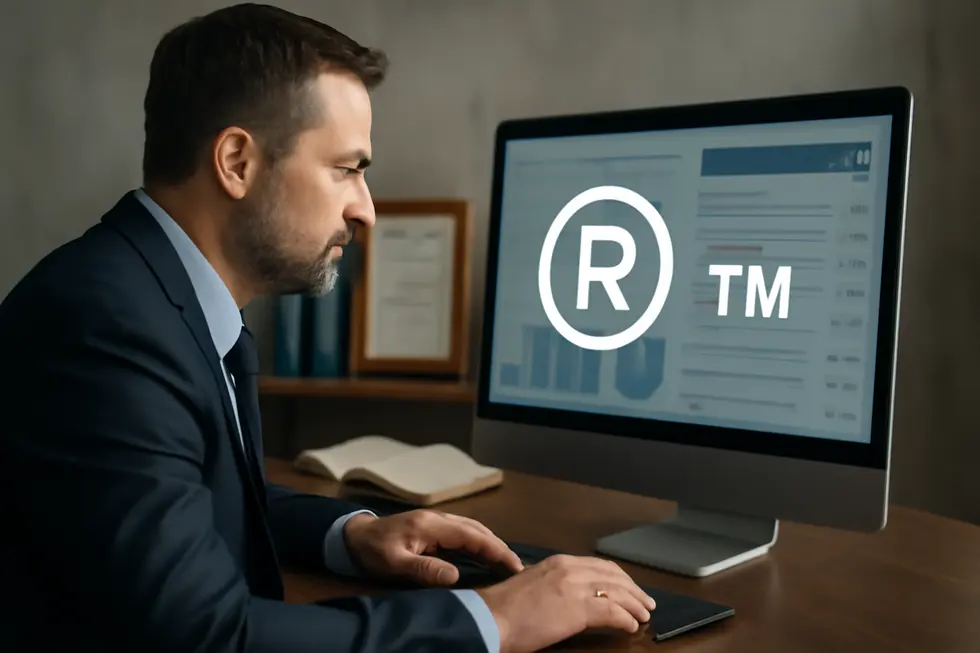Introduction
Your company name is more than just a label—it embodies your brand, reputation, and business value. Protecting it effectively ensures you safeguard your identity from competitors, imposters, and legal disputes that could erode your hard-earned brand equity. This protection involves a layered approach integrating federal trademark registration, state-level business registration, digital safeguards, and legal agreements. Addressing each aspect comprehensively empowers business owners to build strong brand foundations that endure. In the first chapter, you’ll learn why federal trademark registration is vital for nationwide protection. Then, explore how conducting a thorough trademark search prevents conflicts before registration begins. Next, discover the importance of recording your business name at the state level to guard your identity locally. Digital brand control follows, emphasizing securing domain names and social media handles to stop online impersonation. The fifth chapter explains how non-disclosure agreements (NDAs) and confidentiality agreements shield your intellectual property internally. Finally, ongoing maintenance and enforcement of trademark rights ensure your protection stays effective against infringement and dilution. Together, these strategies form a robust defense to protect your company name and secure your competitive advantage.
Tables of Contents
Chapter 1: How to Protect Your Company Name: The Importance of Federal Trademark Registration
- Securing Nationwide Priority and Exclusive Rights Through Federal Trademark Registration
- Understanding the Legal Presumption of Ownership Through Federal Trademark Registration
- Unlocking Federal Courts and Legal Protections: The Power of Federal Trademark Registration
- Elevating Brand Credibility and Growth with Federal Trademark Registration
Chapter 2: How to Protect Your Company Name: Conducting a Comprehensive Trademark Search
- Mastering Trademark Searches: Navigating Federal, State, and Common Law Databases to Secure Your Company Name
- Thorough Trademark Searching: Leveraging Common Law and Digital Tools to Safeguard Your Company Name
- Enhancing Trademark Searches with AI to Secure Your Company Name
- Ensuring Unique Brand Identity: The Vital Role of Legal Expertise in Trademark Searches
Chapter 3: How to Protect Your Company Name: Registering Your Business Name at the State Level
- Navigating State Business Name Registration: Availability Checks and Compliance Essentials
- Securing Your Company Name Through State Formation Filings: A Crucial Step in Business Identity Protection
- Securing Your Business Identity Early: Utilizing State Name Reservation to Protect Your Company Name
- Strengthening Your Brand Identity: Federal Trademark Registration and Securing Digital Assets
Chapter 4: How to Protect Your Company Name: Securing Domain Names and Social Media Handles
- Building Your Legal Shield: Trademark Registration and Digital Asset Protection for Your Brand
- Strategic Digital Asset Protection: Ensuring Your Company Name’s Presence Across Domains and Social Platforms
- Balancing Costs and Brand Security: Economic Strategies for Domain and Social Media Protection
- Proactive Brand Monitoring and Enforcement to Safeguard Your Digital Identity
Chapter 5: How to Protect Your Company Name: Using NDAs and Confidentiality Agreements to Safeguard Sensitive Information
- Clarifying What Constitutes Confidential Information to Strengthen Your Company Name Protection
- Legal Registration and Strategic Name Protection: Combining Trademarks, Business Formation, and NDAs
- Crafting and Enforcing NDAs to Shield Your Company Name and Sensitive Information
- Vigilant Monitoring and Assertive Enforcement: Safeguarding Your Company Name Through NDAs and Confidentiality Agreements
Chapter 6: How to Protect Your Company Name: Maintaining and Enforcing Trademark Rights
- Harnessing Trademark Registration to Secure and Sustain Your Company Name
- Vigilant Brand Surveillance and Decisive Enforcement to Safeguard Your Company Name
- Sustaining Brand Authority Through Strategic Licensing and Timely Trademark Renewals
- Global Brand Shielding: Strategic International Protection and Enforcement of Your Company Name
Chapter 1: How to Protect Your Company Name: The Importance of Federal Trademark Registration

1. Securing Nationwide Priority and Exclusive Rights Through Federal Trademark Registration
Federal trademark registration with the USPTO provides your company name with invaluable nationwide priority and exclusive rights. Unlike state registration, which limits protection to a single state, federal registration grants you the exclusive right to use your mark nationwide in connection with your goods or services. This legal advantage means you can prevent others from using confusingly similar names anywhere in the U.S., even in states where you have not yet expanded your business. Additionally, federal registration establishes constructive notice to the public, effectively notifying competitors of your claim and shifting the burden of proof to challengers. This nationwide priority strengthens your position in infringement disputes and court enforcement, while allowing you to use the ® symbol that signals your brand’s official registration and credibility. Relying on federal registration is essential to maintain broad, enforceable control over your company name as your business grows. For more on trademark protection and registration benefits, visit trademark protection business name and logo.
2. Understanding the Legal Presumption of Ownership Through Federal Trademark Registration
Federal trademark registration creates a powerful legal presumption that reinforces your exclusive ownership of your company name nationwide. This presumption acts as prima facie evidence, meaning the law treats your registered mark as valid and your rightful property without requiring further proof. It grants you the exclusive right to use your company name for the registered goods or services across the entire United States, surpassing the limited territorial reach of common law trademark rights. This nationwide recognition strengthens your position in disputes by shifting the burden of proof to challengers, streamlining enforcement and litigation. Additionally, registration serves as public notice, deterring others from adopting confusingly similar names. It also enables the use of the ® symbol and allows trademark recordation with U.S. Customs to combat counterfeit imports. Such robust protections highlight why obtaining a federal registration is a critical step in safeguarding your brand. For more comprehensive insights on trademark protection, explore this resource on trademark protection for business names and logos.
3. Unlocking Federal Courts and Legal Protections: The Power of Federal Trademark Registration
Federal trademark registration is vital because it grants exclusive rights to enforce your company name nationwide through federal courts. Unlike unregistered or state-registered marks, only federally registered trademarks allow you to bring infringement lawsuits in federal court, offering more efficient and comprehensive remedies. Registration creates a legal presumption of ownership, simplifying disputes and enforcement efforts. This status empowers owners to seek injunctions that stop unauthorized use, claim damages including infringers’ profits, and recover attorney’s fees—remedies often unavailable without federal registration. Additionally, the use of the ® symbol publicly signals your trademark’s protected status, deterring potential infringers. Even supplemental registrations provide access to federal legal channels. Proper federal registration also strengthens licensing agreements by ensuring quality control and reducing risks of third-party claims. For a deeper understanding of trademark protection strategies, see this resource on trademark protection for business names and logos.
4. Elevating Brand Credibility and Growth with Federal Trademark Registration
Federal trademark registration is a pivotal strategy to elevate your company’s credibility and foster sustainable growth. It grants you exclusive nationwide rights, allowing use of the ® symbol that signals authenticity and builds consumer trust. This official recognition safeguards your brand by preventing confusingly similar names from entering the market, protecting your reputation and revenue streams. Moreover, registration creates valuable intellectual property assets that increase your business’s worth and can be licensed or sold. Beyond legal protection, a federal trademark supports expansion opportunities, including international registrations, while helping combat counterfeiting and fraud. The registration process itself can be navigated more effectively with legal expertise or AI-driven tools, ensuring accuracy and efficiency. Ultimately, federal registration transforms your company name into a powerful business asset that supports credibility, competitive edge, and long-term growth. For a detailed understanding, explore resources on trademark protection for business names and logos.
Chapter 2: How to Protect Your Company Name: Conducting a Comprehensive Trademark Search

1. Mastering Trademark Searches: Navigating Federal, State, and Common Law Databases to Secure Your Company Name
Protecting your company name begins with a thorough trademark search across federal, state, and common law sources. Start with the USPTO’s Trademark Electronic Search System (TESS) to identify federally registered marks and pending applications that might conflict with your name. This includes searching word marks and, if applicable, design codes relevant to logos. Complement this by checking state trademark and business name databases, typically accessible via state Secretary of State websites, to uncover registrations and entity names that federal searches may miss. Also, explore common law rights by reviewing online platforms, social media, and industry directories where unregistered marks may hold legal significance based on use. Carefully analyze search results for similarity in sound, appearance, and goods or services to assess risks. Because trademark searching and interpretation involve nuance, consulting an intellectual property attorney can help ensure accurate evaluation and guide application filing. This comprehensive search strategy reduces infringement risks and solidifies your company name’s distinctiveness. For further details on protecting business names, see resources on common law trademark rights.
2. Thorough Trademark Searching: Leveraging Common Law and Digital Tools to Safeguard Your Company Name
Conducting a comprehensive trademark search is essential for protecting your company name from potential conflicts. This involves investigating registered trademarks through the USPTO’s Trademark Electronic Search System (TESS), as well as state trademark and business name databases. Beyond formal registrations, common law rights protect unregistered marks, making it crucial to explore sources like Google, social media platforms, industry directories, and domain registries for existing uses. Securing matching domain names and social media handles also prevents brand impersonation online. To enhance the search’s accuracy and efficiency, AI-powered tools analyze phonetic, visual, and conceptual similarities across vast databases. Once gathered, carefully analyze results for any confusing similarities in appearance, sound, or the marketplace. Consulting an intellectual property attorney during this process helps assess risks and legal viability. Employing these strategies collectively minimizes infringement risks and solidifies your brand’s identity. Learn more about protecting your trademark rights through common law protections and related guidance.
3. Enhancing Trademark Searches with AI to Secure Your Company Name
Conducting a comprehensive trademark search is crucial for protecting your company name, and integrating AI-powered tools elevates this process significantly. Advanced AI algorithms swiftly scan extensive trademark databases, detecting not only exact matches but also subtle textual, phonetic, and visual similarities that manual checks might overlook. These AI-driven platforms analyze logos and design elements using image recognition technology, uncovering variations in color, font, or shape that could pose infringement risks. By applying the international Nice Classification system, AI tools ensure searches are focused within relevant goods or services categories, reducing registration conflicts. Additionally, AI’s ability to interpret multilingual and cultural nuances supports businesses aiming for international presence, while continuous AI monitoring tracks your trademark’s online use, helping safeguard against unauthorized exploitation. Combining AI-enhanced searches with official trademark databases and expert legal counsel strengthens your defense, minimizing risks and laying a robust foundation for your brand’s exclusive rights. For a deeper understanding of foundational trademark protections, explore guidance on trademark protection for business names and logos.
4. Ensuring Unique Brand Identity: The Vital Role of Legal Expertise in Trademark Searches
Conducting a comprehensive trademark search is essential to securing your company name, but pairing this with professional legal consultation significantly strengthens your protection strategy. This process starts by clearly defining your trademark’s elements, including name variations, logos, and associated goods or services, thereby focusing the search for conflicting marks. Beyond preliminary checks using online search engines and the USPTO’s TESS database, a thorough investigation must encompass state trademark registries, common law uses, domain names, and international records. Employing AI-powered tools enhances this search by identifying phonetic and visual similarities that could otherwise be missed. Critical too is exploring variant spellings and design classifications through USPTO resources to avoid unforeseen conflicts. A trademark attorney’s expertise is invaluable for interpreting complex results, assessing risks, and guiding the trademark application to avoid procedural pitfalls. Complementing searches with state registration and securing your digital assets further consolidates your brand’s legal footprint. For an insightful framework on this process, visit trademark protection for business name and logo. This integrated approach not only mitigates infringement risks but also fortifies your brand’s uniqueness and legal security.
Chapter 3: How to Protect Your Company Name: Registering Your Business Name at the State Level

1. Navigating State Business Name Registration: Availability Checks and Compliance Essentials
Protecting your company name starts with verifying its availability through your state’s Secretary of State business entity database. This step ensures no other business operates under the same or a confusingly similar name within that jurisdiction. Since each state manages independent records and rules, conducting these searches in every state where you plan to operate is vital. Once confirmed, registering your name involves filing Articles of Incorporation or Organization and paying the applicable state fee, thereby securing your legal protection within that state. Compliance extends beyond registration, requiring adherence to naming conventions (like including LLC or Inc.), obtaining necessary business licenses or tax registrations, and fulfilling annual reporting obligations to maintain good standing. Additionally, promptly securing domain names and social media handles matching your registered business name solidifies your digital presence and helps prevent brand impersonation. Multistate operations demand repeating these steps per jurisdiction, reinforcing your business name’s protection at every level. For detailed procedural guidance, learn more at co-name business guide.
2. Securing Your Company Name Through State Formation Filings: A Crucial Step in Business Identity Protection
Protecting your company name at the state level begins with filing formation documents with the state’s Secretary of State or an equivalent agency. This process starts by confirming your desired name is available and not already used by existing entities, typically through an online database search. Selecting the appropriate business structure—whether an LLC, corporation, or partnership—influences which formation documents are required, such as Articles of Organization or Incorporation. These documents, submitted with state-mandated fees, must include key information like your company name, principal address, and registered agent. Upon approval, the state issues official confirmation, legally recognizing your business and safeguarding its name within that jurisdiction. For added protection, registering a DBA or assumed name is essential if you operate under an alternate business name. While this state-level registration secures your name locally, pairing it with a federal trademark strengthens your brand’s exclusive rights. Additionally, securing digital assets like domain names and social media handles is vital to defend your brand online. For precise details and forms, consult your state’s Secretary of State website. To understand how these protections integrate with broader intellectual property rights, explore resources on trademark protection of business names and logos.
3. Securing Your Business Identity Early: Utilizing State Name Reservation to Protect Your Company Name
Securing your company name begins with a thorough name availability check through your state’s Secretary of State online portal. If your desired name is available, many states offer a name reservation option, allowing you to hold that name exclusively for a period typically ranging from 30 to 120 days. This temporary reservation requires a modest fee, usually between $10 and $50, and prevents competing businesses from registering the same name while you finalize your business formation documents, such as Articles of Organization or Incorporation. Since each state varies in reservation rules, fees, and duration, it’s essential to consult your specific state’s guidelines. While this reservation provides vital short-term protection within that jurisdiction, completing official registration solidifies your rights to the name. To fortify your brand further, immediately securing matching domain names and social media handles helps protect your digital presence. For comprehensive and nationwide protection, consider federal trademark registration, a crucial step to enforce exclusive rights beyond state boundaries. For additional details on registering and protecting your business name, refer to this guide on trademark protection for business names and logos.
4. Strengthening Your Brand Identity: Federal Trademark Registration and Securing Digital Assets
To comprehensively protect your company name, federal trademark registration provides nationwide exclusive rights and a strong legal foundation. This registration not only grants the right to use the ® symbol, enhancing your brand’s credibility, but also allows enforcement of your trademark in federal courts. It serves as a deterrent to infringers and supports international expansion efforts. Equally crucial is securing your digital presence; promptly registering domain names—including common variants and different extensions—and claiming your company name across social media platforms prevents impersonation and misuse. Employing domain privacy safeguards your ownership information against public exposure. Building a trademark portfolio by including logos, slogans, and product names further solidifies your protections. Continuous monitoring and timely renewals ensure your trademark rights remain intact. Together, federal registration and digital asset management form a robust shield that protects your brand legally and online, complementing state-level protections effectively. For deeper insights into trademark protection strategies, exploring specialized resources like trademark protection for business names and logos is highly recommended.
Chapter 4: How to Protect Your Company Name: Securing Domain Names and Social Media Handles

1. Building Your Legal Shield: Trademark Registration and Digital Asset Protection for Your Brand
Trademark registration is the cornerstone of legally protecting your company name. Securing a registered trademark through the USPTO grants you nationwide exclusive rights, strengthens enforcement options, and lets you use the ® symbol, signaling your ownership. Equally important is registering your primary domain name along with common variations and country-specific extensions to block cybersquatters from exploiting your brand online. When domain disputes occur, mechanisms like the Uniform Domain-Name Dispute-Resolution Policy (UDRP) offer a practical path to reclaim infringing domains without costly litigation. Early reservation of social media handles on major platforms prevents unauthorized accounts that might confuse customers or damage brand reputation. Together with regular monitoring and intellectual property audits, these steps create a robust, layered defense to maintain brand integrity. Preparedness to enforce your rights through cease-and-desist letters or legal actions ensures active protection. For detailed procedural steps and tailored advice, consulting resources on trademark protection for business names and logos can be invaluable.
2. Strategic Digital Asset Protection: Ensuring Your Company Name’s Presence Across Domains and Social Platforms
Protecting your company name in the digital world requires carefully securing your domain names and social media handles to maintain control over your brand identity. Start by registering your trademark to create a legal foundation that supports enforcement of your rights online. Acquiring the exact match domain for your company name, as well as common variations including misspellings and relevant country extensions, prevents cybersquatters from exploiting your brand. Select concise, memorable domain names—ideally under 15 characters—to improve user recall and search performance. Simultaneously, claim your social media handles consistently across all major platforms to avoid impersonation and confusion. Continuous digital monitoring using specialized tools helps detect unauthorized use early, allowing swift action. Complement these efforts with an internal brand usage policy to guide employees and partners in upholding brand standards. This comprehensive digital strategy forms a critical layer of defense in securing your company name’s reputation and customer trust. For deeper insights, consider exploring trademark protection nuances at trademark2go.com/trademark-protection-business-name-logo/.
3. Balancing Costs and Brand Security: Economic Strategies for Domain and Social Media Protection
Balancing Costs and Brand Security in Digital Asset Protection
Securing your company name extends beyond registration to include domain names and social media handles, requiring thoughtful economic planning. Domain registration fees generally range from $10 to $80 annually depending on the extension, with renewals often costing more than initial registrations. Investing in multiple domains—including popular and regional extensions—can prevent cybersquatting and preserve your brand’s global integrity but adds to the budget.
Social media handles usually carry no direct fees, yet maintaining consistent profiles demands ongoing time and monitoring to avoid misuse or impersonation. Trademark registration enhances protection by equipping you with legal tools to combat infringement, though this increases expenditure through registration fees and enforcement costs such as trademark watch services.
Proactive domain and social media control reduces risks linked to cybersquatting and counterfeit activities, which often incur higher unforeseen expenses. Carefully balancing these investments against potential losses safeguards brand identity and supports sustainable growth.
For a deeper understanding of trademark protection linked to your brand identity, consult this resource on trademark protection for business names and logos.
4. Proactive Brand Monitoring and Enforcement to Safeguard Your Digital Identity
Protecting your company name in the digital realm demands vigilant brand monitoring paired with swift enforcement actions. Early registration of domain names and social media handles is essential to block impersonators before they act. Leveraging trademark watching services helps detect new filings or registrations that may infringe on your brand, enabling prompt responses. Continuous surveillance across online marketplaces, social networks, and DNS records ensures unauthorized uses, phishing attempts, or counterfeit profiles are identified quickly. When infringement is discovered, coordinated legal steps such as cease-and-desist letters or takedown requests are critical to preserving your brand’s integrity without escalating unnecessary disputes. Prioritizing threats based on their potential damage allows focused resource allocation, while maintaining thorough records supports ongoing protection efforts. This integrated approach maintains consistent brand presence, builds customer trust, and defends your company name’s value. For deeper insights on trademark protections, consider resources like trademark protection business name and logo.
Chapter 5: How to Protect Your Company Name: Using NDAs and Confidentiality Agreements to Safeguard Sensitive Information

1. Clarifying What Constitutes Confidential Information to Strengthen Your Company Name Protection
Confidential Information lies at the heart of protecting your company name through NDAs and confidentiality agreements. It encompasses any sensitive or proprietary data critical to your business’s competitive edge, such as financial records, customer lists, business plans, trade secrets, or product designs. A robust agreement precisely defines this information to avoid ambiguity and ensure legal enforceability. It must specify what is confidential—whether written, verbal, or digital—outline who is bound to secrecy, and clarify exceptions like publicly known or independently developed information. Duration is also key, with obligations lasting either a set period or indefinitely, depending on the nature of the data. Clear definitions not only prevent unauthorized disclosure but also pave the way for legal recourse if breached. For businesses aiming to secure their brand’s identity, understanding how to define and protect confidential information is an essential step in safeguarding their company name against misuse and infringement. For a practical guide on crafting effective confidentiality clauses, explore this resource on copyright information for business owners.
2. Legal Registration and Strategic Name Protection: Combining Trademarks, Business Formation, and NDAs
Protecting your company name begins with registering your business legally at the state level by filing formation documents and paying the required fees. This step secures your official identity within that jurisdiction. To achieve nationwide exclusivity, registering your company name as a federal trademark with the USPTO is essential. This involves a thorough trademark search, selecting the right classes, submitting an application, and navigating any office actions to obtain registration. This federal registration grants the right to use the ® symbol and strengthens your position against infringement.
Alongside legal filings, protecting your digital presence by securing domains and social media handles tied to your name prevents online impersonation and brand dilution. Equally important are Non-Disclosure Agreements (NDAs) and confidentiality agreements. These legally bind employees, contractors, and partners to protect your company’s trade secrets and sensitive information, crucial during negotiations or collaborations. This integrated approach of legal registration, digital asset protection, and strong confidentiality measures forms a robust defense for your company name and intellectual property. For more on trademark protection, see common strategies in protecting your business name.
3. Crafting and Enforcing NDAs to Shield Your Company Name and Sensitive Information
Effectively protecting your company name through NDAs begins with drafting precise agreements that clearly define what constitutes confidential information. This includes business plans, customer lists, and trade secrets, ensuring no ambiguity undermines enforcement. NDAs must outline the receiving party’s obligations to safeguard this information, prohibiting unauthorized disclosures while allowing for legally mandated exceptions. The agreement should specify how long confidentiality lasts, which could be a fixed term or indefinite for trade secrets, and clarify exclusions like publicly known data. Including governing law and dispute resolution clauses reinforces legal strength. Enforcement demands all parties sign before any sensitive information exchange, combined with internal education on the importance of confidentiality. Regular monitoring through audits or access controls helps detect breaches early. Tailoring NDAs to jurisdictional requirements is essential, as courts may uphold or reject agreements based on fairness and clarity. A well-structured and enforced NDA forms a crucial barrier guarding your company’s identity and proprietary assets. For additional insights on protecting your brand identity, see trademark protections for business names.
4. Vigilant Monitoring and Assertive Enforcement: Safeguarding Your Company Name Through NDAs and Confidentiality Agreements
Vigilant Monitoring and Assertive Enforcement are essential for protecting your company name through NDAs and confidentiality agreements. Begin by crafting precise agreements that clearly define confidential information, obligations, and timeframes, leaving no room for ambiguity. Ensure every employee, contractor, or partner signs these agreements before exposure to sensitive data. Proactive education about confidentiality responsibilities enhances compliance and awareness.
Consistent monitoring involves tracking information flow internally and using trademark watching services to catch unauthorized brand use early. Online and marketplace surveillance helps identify counterfeit or infringing activities swiftly. When breaches occur, prompt legal enforcement—such as injunctions or damages—sends a strong deterrent message. Cultivating a culture respectful of intellectual property internally minimizes risks of accidental disclosures or leaks.
This integrated approach combining clear legal protections, ongoing vigilance, and decisive action ensures your company name remains a secure and valuable asset. For more on emphasizing trademark protections alongside confidentiality, visit trademark protection for business name and logo.
Chapter 6: How to Protect Your Company Name: Maintaining and Enforcing Trademark Rights

1. Harnessing Trademark Registration to Secure and Sustain Your Company Name
Trademark registration is pivotal for securing exclusive legal rights to your company name and ensuring long-term brand protection. Registering federally with the USPTO offers nationwide exclusivity, empowering you to prevent others from using similar names and providing a strong legal foundation to enforce your rights. The process begins with a comprehensive trademark search to avoid conflicts, followed by filing an application and addressing any examination issues. Once granted, your trademark must be maintained through timely renewals and proper use of trademark symbols, reinforcing your brand’s distinctiveness in the marketplace. Vigilant monitoring and enforcement against infringement preserve your trademark’s strength and prevent dilution. Because trademark rights generally favor first-to-file applicants, registering your company name promptly is essential to safeguarding your business reputation. For deeper insights into protecting your business’s identity, explore valuable resources on trademark protection for business names and logos.
2. Vigilant Brand Surveillance and Decisive Enforcement to Safeguard Your Company Name
Vigilant brand surveillance is essential to defend your company name from unauthorized or confusingly similar uses. This includes continuous monitoring of new trademark filings at both federal and state levels, tracking domain name registrations, social media accounts, and e-commerce platforms where infringement can occur. Leveraging advanced AI-powered tools enhances real-time detection of potential conflicts or counterfeits that could dilute your brand’s value. Once an infringement is identified, prompt and decisive enforcement actions are critical. These often begin with cease-and-desist letters aimed at halting misuse before escalation. In stubborn cases, filing oppositions, cancellations, or pursuing litigation may be necessary to fully protect your rights. Consistent enforcement helps prevent weakening or abandonment of your trademark and upholds your exclusive brand identity. Engaging specialized legal counsel can streamline managing these processes and optimize protection strategies. For further insights on monitoring your trademark effectively, explore trademark portfolio management resources to strengthen your brand defenses.
3. Sustaining Brand Authority Through Strategic Licensing and Timely Trademark Renewals
The continued protection of your company name hinges on consistent trademark renewal and careful licensing management. Federal trademark registration offers valuable legal benefits that only persist with proper renewal filings, such as the Section 8 Declaration of Use and Section 9 Application, required within specific timeframes to maintain exclusive nationwide rights. Failing these deadlines risks losing registered protections, leaving only limited common law rights. Simultaneously, licensing agreements must be structured to uphold trademark quality and prevent dilution. A well-managed license not only expands your brand’s reach but also reinforces its strength by controlling how the mark is used. This requires ongoing oversight to ensure compliance and swift enforcement against misuse. Together, renewal diligence and informed licensing serve as pillars of your trademark strategy, preserving your company name’s integrity and legal enforceability. For detailed guidance on trademark renewal processes, see trademark name protection.
4. Global Brand Shielding: Strategic International Protection and Enforcement of Your Company Name
Protecting your company name internationally demands a strategic approach focused on targeted market selection and comprehensive trademark registration. Prioritize registering your name where your brand operates or plans to expand, especially in regions prone to trademark squatting like China or Latin America. Utilize the Madrid Protocol to streamline filings across multiple countries, but consider direct national registrations in critical markets for stronger local control. Beyond your company name, register associated logos, slogans, and foreign language variants to block others from exploiting linguistic differences. Vigilant monitoring of international trademark registers enables early detection of infringement, allowing timely opposition. Regular portfolio maintenance, including renewals and updates, prevents loss of rights from inactivity. Enforcement across borders requires clear dispute resolution terms and cooperation with local authorities to combat infringement effectively. Adapting protection strategies to local laws and consumer expectations ensures consistent brand value worldwide. This integrated approach leverages international treaties and local measures to robustly maintain and enforce your trademark rights on the global stage.
Final thoughts
Protecting your company name is a strategic and ongoing process that goes well beyond initial registration. Federal trademark registration forms the strongest foundation, offering nationwide exclusive rights. Coupled with a thorough trademark search, this ensures you don’t risk infringement or costly legal disputes. State-level business registration further secures your local presence and identity. Digital protection through domain names and social media handles prevents brand hijackers and preserves your online edge. Legal safeguards, including NDAs and confidentiality agreements, protect your company’s sensitive information and intellectual property from internal and external risks. Finally, consistent maintenance and vigilant enforcement defend your brand against unauthorized use and dilution, preserving its value and reputation. By integrating these elements into a comprehensive protection strategy, business owners establish a resilient brand identity that can thrive securely in competitive markets.
Your IP is the foundation of your success – let’s protect it together before it’s too late. We can’t wait to help you turn your ideas into legally secured assets.
About us
undefined


